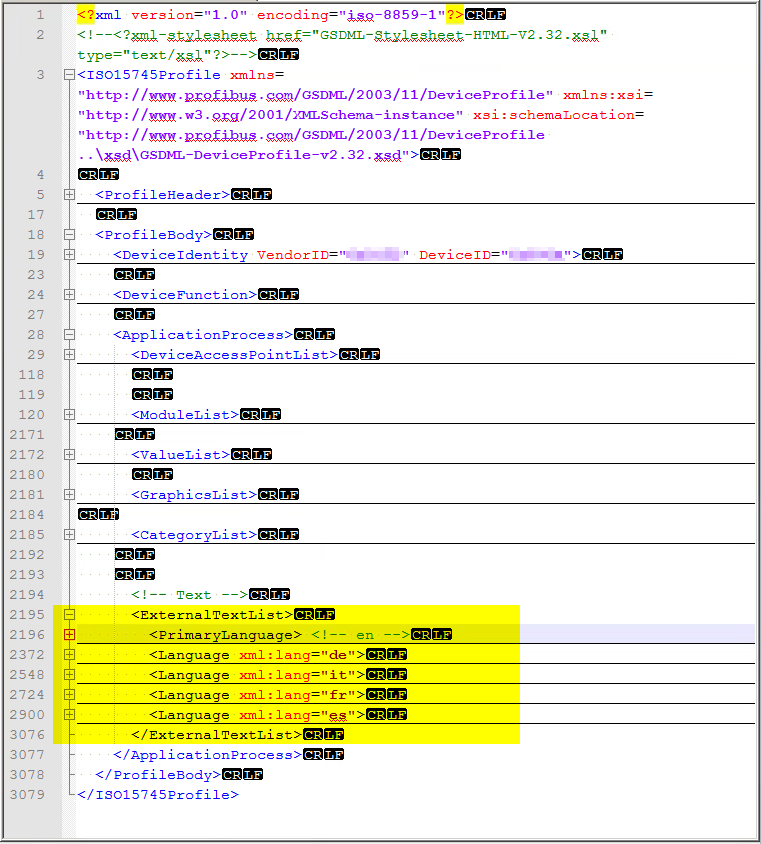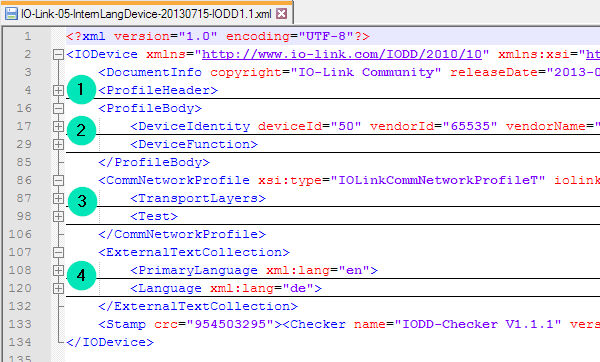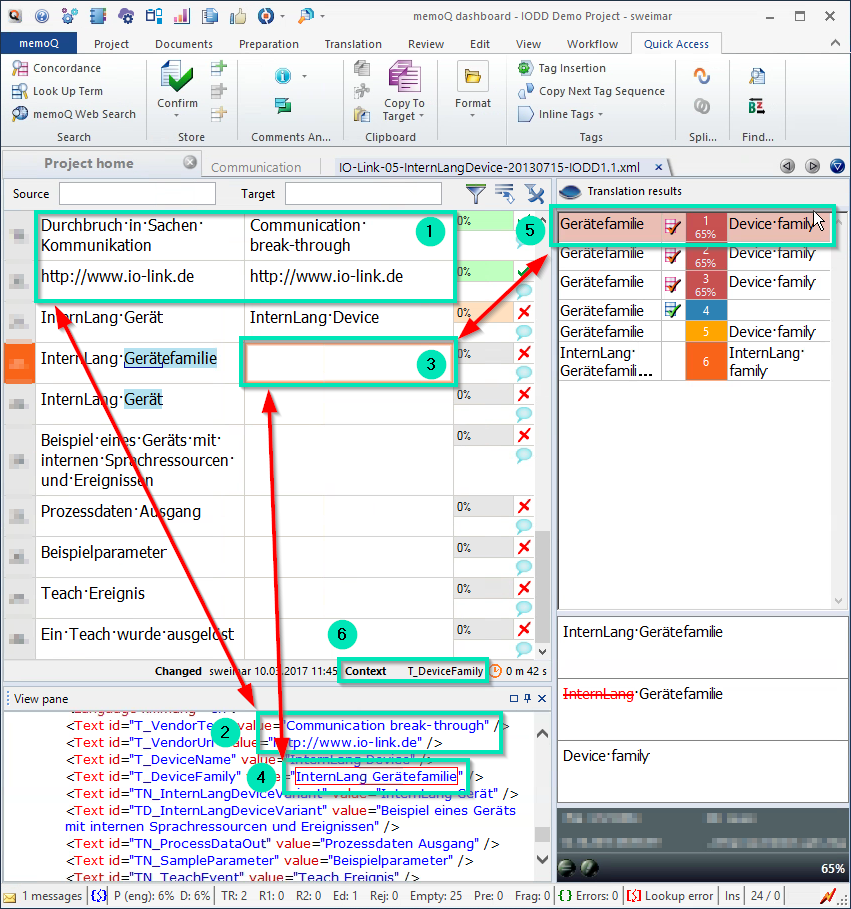Localization in the age of Industry 4.0
The objectives of Industry 4.0 and IoT at industrial level are:
- improving operational effectiveness through intelligent systems and more flexible production techniques
- production with lot size 1
- improvement of human-machine interaction
The underlying machine-machine communication is based on bus protocols such as PROFIBUS, PROFINET, IO-Link, OPC UA …
Of course, in addition to machine-to-machine communication, users must also be informed and information exchanged between human and machine.
Human-machine communication
The communication of machine data to the operator takes place either via device software or via configuration files such as IODD for IO-Link or GSMDL for PROFINET. It would be advantageous if machine/device/sensor could communicate directly with the user in his language.
The localization of device software is already taking place on a larger scale. But many manufacturers neglect the localization of configuration files.

Many customer-specific file formats
In the area of human-machine communication, there are many customer-specific file formats, some of which are nested within one another.
We sometimes ask for the translation of XML data with embedded HTML. PRODOC has created its own filter for this purpose. Precisely that what has to be translated is translated and we get valid XML files back!
Localizing configuration files
Configuration files such as GSDML files for PROFINET or IODD files for IO-Link usually contain a separate section containing information on the status of the process/device. The contents of this section can be entered in several languages and are used for user information on the display/PLC/industrial PC.
PRODOC can edit these Industry 4.0 configuration files directly in the CAT tool:
- No copy&paste – no media disruptions
- Use of company terminology
- Integration into the translation workflow for instructions
In the following, we use IODD files and GSDML files as examples to show how typical formats for IoT and Industry 4.0 can be localized.
Do you have data in a special format that you would like to have translated?
Request quote
Dipl.-Ing. Stefan Weimar
Managing Director
Translating PROFINET GSDML files
Description of device properties via GSDML
GSDML (GSD Markup Language) is an XML-based language that is used to create GSD files in XML format. The GSD file is used in development environments to configure and plan PROFINET IO systems.
GSD or specific GSDML files are an integral part of a PROFINET device. In the GSDML file, properties of the device, such as parameters and functions, are described by the device manufacturer.
Translation-relevant part of the GSDML file
Parts of these descriptions are language information that are required for the configuration of the PROFINET system and are displayed in the development environment.
This language information is usually available in English, but can also be translated into other languages.
For this purpose, the GSDML file contains the section ExternalTextList with the subsection PrimaryLanguage and other language sections:
These sections are relevant for technical translation and can be translated directly using memoQ.
The ExternalTextList area
Explanatory texts for parameters and functions of the PROFINET device are saved in this area.
PrimaryLanguage
The ExternalTextList area always contains the PrimaryLanguage section, which usually contains information in English.
Language
There can be any number of additional sections Language, one for each foreign language.
These sections contain the translation of the text from PrimaryLanguage.
Structure of the Language section
The Language section only contains XML tags of type Text with the two attributes TextId and Value.
Only the value of Value needs to be translated.
The TextId attribute is a variable that enables the assignment to the respective device parameter for the configuration.
Translating IODD files
An IODD file is a device description file for the IO-Link system. In this file, standardized device parameters such as manufacturer and product information are filled with values that tell the IO-Link system how the device works and its communication parameters.
Detailed information can be found at io-link.com.
An IODD file is an XML file with UTF-8 encoding and is structured as follows:
ProfileHeaderwith information on the underlying IO-Link profileProfileBodywith information on manufacturer and device functionCommNetworkProfilewith information on communication parametersExternalTextCollectionwith language-specific information
Translation-relevant part of an IODD file
The area ExternalTextCollection
Language-relevant information, such as display texts for the sensor or actuator or messages for the PLC, can be embedded in this area.
PrimaryLanguage
The ExternalTextCollection area always contains the PrimaryLanguage report, which usually contains information in English.
Language
Any number of additional areas Language can be included, one for each foreign language.
The translation of the text from PrimaryLanguage is placed in these areas.
Structure of the Language area
The Language area only contains XML tags of type Text with the two attributes id and value.
Only the value of value needs to be translated.
The id attribute serves purely as context information.
Possible approaches to translation
That is risky to say the least. The translator must know exactly what he is doing.
Validating the translated file is essential!
In addition, the translations are then only available in the Industry 4.0 configuration file and not in the translation memory of a CAT tool such as memoQ
The development engineer, who knows the configuration file, copies the language-relevant texts into an Excel file. This Excel file is translated using a CAT tool. The translation is delivered in the form of an Excel file and the development engineer has to copy and paste each individual text in an extremely time-consuming process.
Validating the file is also essential here!
However, the translations are at least available in the translation memory and can be used as reference material for the translation of the corresponding manual.
This is the most efficient and safest way. The import filter ensures that only the correct texts are translated.
The translations are in the right place after export from the CAT tool.
Validation is not required!
The import filter prevents the editing of tags and other texts that must not be translated.
Direct translation with memoQ
Using an IODD file as an example, we show how configuration files are translated in the CAT tool.
We have configured an import filter for our CAT tool memoQ that only makes the content of the value attribute editable and saves the content of the id attribute as context information.
We can import the IODD file directly and translate it into any number of languages.
As an example, here is a file that we downloaded directly from io-link.com.
After the import, the IODD file in memoQ looks like this.
The screenshot shows the status during translation in memoQ.
- These texts were translated and confirmed manually.
- This is the preview of the translated text in the IODD file.
- The English translation should be entered here. It is helpful to make an entry in the translation memory.
- In the preview, the text to be translated in the current segment is framed in red. Since nothing has been entered yet, the German text is still displayed.
- The Translation results area shows the existing translations in the translation memory. “Gerätefamilie” has already been translated as “Device family” and can be adopted with a mouse click.
- This is the entry ID, i.e. T_DeviceFamily. This is not editable and is purely informative, but is saved in the translation memory as an additional reference.
This makes it easy to see that only texts that are relevant for translation are displayed and can be edited by the translator. The remaining XML code remains protected.
Advantages of translating in memoQ
The translator has access to the full range of memoQ functions, i.e. translation memories, termbases, LiveDocs, etc., and can translate quickly and efficiently in the familiar environment.
As only the texts to be edited can be edited at all, the integrity of the XML data in the configuration file is securely maintained.
The translation is saved in the translation memory and is therefore available, for example, for efficient translation of configuration file updates and for translations of similar configuration files.
Even if only German-English or English-German is translated, this translation can then be used to have the German or English texts available as references for the translation of operating instructions into other languages.
The term Industry 4.0
The term Industry 4.0 refers to the generally established term for software updates. The number before the decimal point stands for large version jumps. The number 4 stands for the 4th industrial revolution.
The first industrial revolution is the beginning of the use of water and steam power at the end of the 18th century.
Assembly line production in the early 20th century heralded the 2nd industrial revolution.
The 3rd industrial revolution is the name given to the first major wave of digitalization that began towards the end of the 20th century.
- First Industrial Revolution – use of water and steam
- Second Industrial Revolution – assembly line work
- Third Industrial Revolution – Digitalization
The term Industry 4.0 was coined in 2011 by Henning Kagermann, Wolf-Dieter Lukas and Wolfgang Wahlster at the Hannover Messe trade fair.
The term has also been criticized ever since. The main argument put forward is that the current trend is basically a further development of the first wave of digitization, i.e. the third industrial revolution.
How does Industry 4.0 work?
Basically, Industry 4.0 is a concept of organizational design that relates to the automation processes of companies. There are four aspects to this organizational design: networking, also known as the Internet of Things (IoT), transparency, assistance and decentralization.
Challenges of the 4th Industrial Revolution
There is much to suggest that the pressure of international competition makes the integration of elements of Industry 4.0 a must for many companies. However, the development of such a system optimization is a long-term process of unlimited duration, which is often associated with high investment costs. This may also result in far-reaching changes to the corporate structure.
Security is also a major challenge. Protecting both customer data and internal company data is an extremely challenging undertaking with a high degree of networking: The more networked a company is, the greater the number of potential security gaps.
The production processes themselves must also be protected by appropriate safety measures, as machines that are online, for example, can run the risk of being manipulated from outside.
In political and social terms, Industry 4.0 has the potential to throw the labor market into great turmoil. Automation will make more and more occupations obsolete in the future. The way in which this is dealt with is seen as one of the greatest political challenges of the 21st century.
Industry 4.0 worldwide
The term Industry 4.0 was coined in Germany and has so far largely been used in German-speaking countries. However, the trend towards networking and automation is, of course, a global development.
In Japan, for example, the use of networked industrial robots has been booming since the early 21st century. In China, more and more workers are also being replaced by robots.
Even in the USA, this process has long been unstoppable. The term Internet of Things, which is central to Industry 4.0, was coined by the British expert Kevin Ashton, who is responsible for key developments in corresponding technologies at MIT.
What is the Internet of Things?
Just like the Internet of People, the Internet of Things (IoT) is a structure that is used to communicate or exchange data. The difference, however, is that with the Internet of Things, things interact with each other independently of direct human interaction. The aim of the Internet of Things is ultimately also to serve people.
This networking of objects is made possible above all by the development of miniaturized computer chips, sensors and components for data transmission, with which all kinds of everyday objects and industrial machines are equipped.
The IoT and its technologies are a central element of the 4th industrial revolution.
The goal of the IoT is to make the states of the affected things measurable and controllable. This makes it possible to react to certain conditions in order to improve their usability for the consumer.
Technological basics of the Internet of Things
The fundamental technology of the Internet of Things is the development of RFID, radio-frequency identification, a wireless technology that enables objects to be identified automatically and contactlessly using radio waves.
Furthermore, all kinds of sensors and actuators that enable the functionality and detection of states and the execution of actions are now also important elements.
Requirements for the IoT
The basic requirements of IoT technologies include, above all, low energy consumption, low maintenance, high durability and low manufacturing costs.
The meaningful use of IoT technologies for the mass market only makes sense if they can be applied to a very large number of items in an economically viable way.
Only then can the potential of these technologies be fully exploited. The requirements for the software also differ dramatically from all previous implementations.
Above all, IoT-compatible operating systems require the lowest possible memory and energy consumption in line with the architecture of the chips.
Challenges of the Internet of Things
The IoT holds great potential in many areas – it is not without reason that experts agree that it is one of the key economic drivers of the 21st century.
However, in order to bring it to its full potential, research, developers and companies that ultimately want to integrate the IoT into their products and their production face a number of challenges.
Using standardized components and applications is an advantage to achieve the most comprehensively integrated IoT possible, which is necessary to fully leverage its strengths. These standards first have to establish themselves on the market.
The more comprehensive a system is, the more susceptible it tends to be to security vulnerabilities. The more penetrating the network becomes, the greater the potential for damaging the system and causing damage beyond the system itself. Another security factor is the network connection, which is a challenge for companies that use IoT technologies.
Costs are also still a further challenge at present. Although the technologies of the Internet of Things are already available, integrating them into the production of mass-produced goods will quickly cause their manufacturing costs to soar to astronomical figures.
Info required?
If you would like to receive further information on technical translations in the industry 4.0 environment, please use our contact form.
To the contact form
Dipl.-Ing. Stefan Weimar
Managing Director




